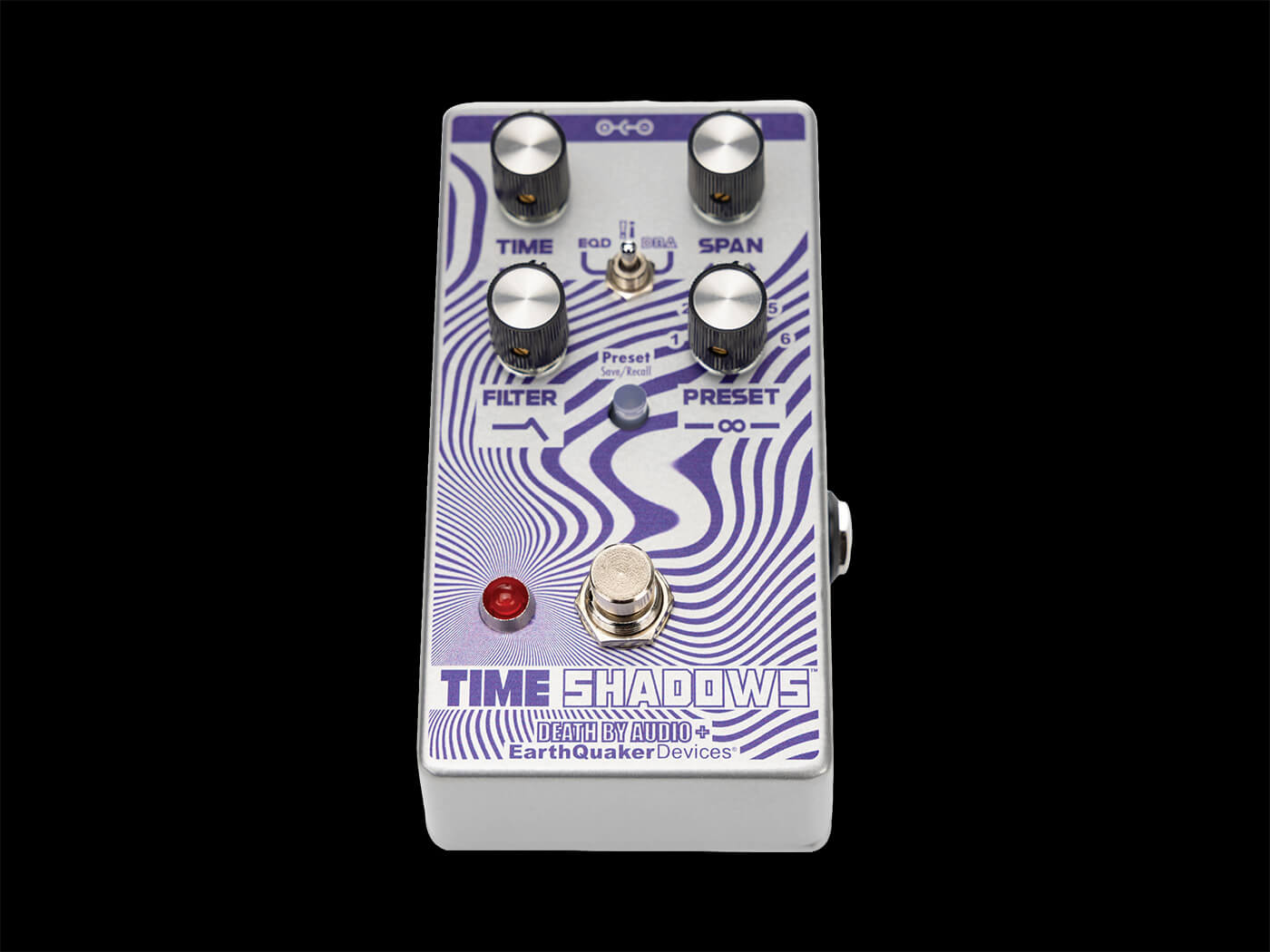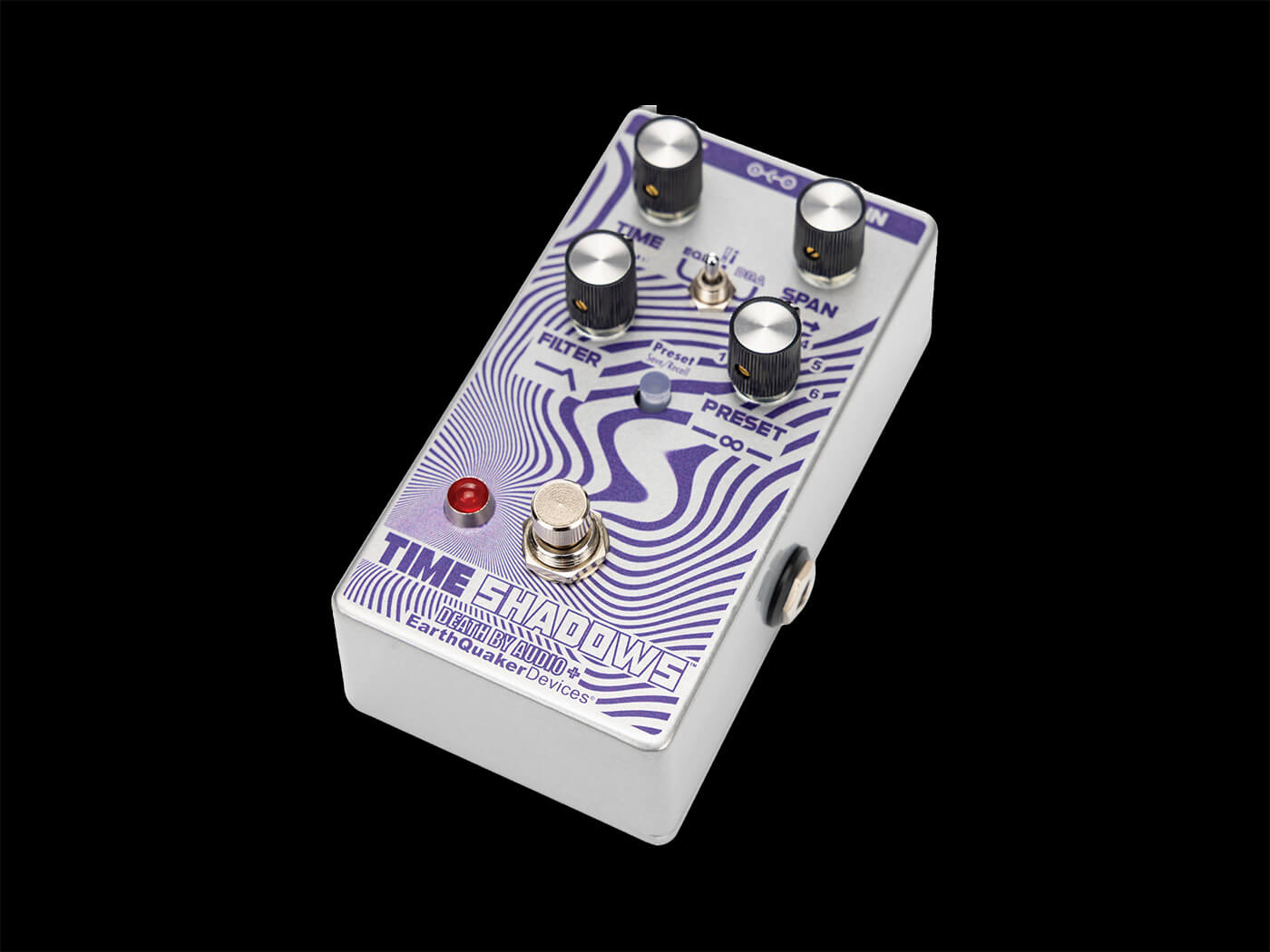Related Tags
Earthquaker Devices x Death By Audio Time Shadows review: energy beams and jazz space bazookas abound
Sick of pondering over the harmonic response of nigh-on identical clipping diodes? Why not eat a slice of Time Shadows and have some fun for once

Earthquaker Devices x Death By Audio Time Shadows
Review Overview
Our rating
9
Our verdict
⊕ Very inspiring to play despite the strangeness of the sound
⊖ Middle mode may be too dissonant for many use cases
Genuinely weird, the Time Shadows is a fantastic collaborative pedal that explores the fringes of what each of its makers is known for.
$199/£199, earthquakerdevices.com
The last time I reviewed an Earthquaker Devices pedal, I was struck by the lack of fantasy bullshit in the manual. Normally there’s at least one mention of wizards – but, that was the Ledges, a three-mode reverb that offered good but relatively prosaic takes on room, hall and plate sounds. So imagine my relief when I opened the manual for the reissued Time Shadows and read phrases like ‘jazz space bazooka’, ‘energy beam’ and ‘telepathic mind-meld with a fifth-dimensional being’. We’re back on home turf, baby, and home turf is the aftermath of an acid-addled DND session.
The Time Shadows – initially released in 2020 as a limited exclusive alongside Reverb’s Pedal Movie – is back as a permanent part of the lineup. It’s a collaboration with Death By Audio, with each of the original’s two modes being designed by one of the companies. For the reissue, there’s a new middle mode, as well as the same expression and preset save/recall functionality you’ll find on the Ledges – six preset slots, and an expression jack assignable to any of the main controls. So, some notable changes – but still essentially the same pedal at its core.

What is the Time Shadows?
In the best way possible: I haven’t the foggiest. EQD calls it a Subharmonic Multi-Delay Resonator, but given that the general functionality varies massively across the three modes, even that seems insufficient. And, on all three modes, the resulting sounds are strange enough to make you understand why EQD’s manual uses words like ‘remorphinator’ instead of real ones. I could attempt to map out the signal path of each mode in a little flow chart, but that would likely be boring and pointless for everyone. As you’ll see, my own experiences with the pedal don’t easily put it in its own box. So, rather than trying to, let’s just say it’s a pedal, and enjoy what it can do.
EarthQuaker mode
‘Jazz space bazooka’, in practice, means enveloping distorted swells, running into a gritty delay that’s smeary enough to basically cross over into reverb. Adding to the impact is a polyphonic sub-octave blended in at the beginning of the chain. The filter control here both selects the cutoff for the low-pass envelope and adjusts the gate on the input – there’s a huge sweep, ranging from barely-audible rumble to piercing, resonant screeches. It’s not an auto-wah – this is a full-on modular-synth resonant filter swell. I find my favourite sound with it at about 9 o’clock, along with high delay time and feedback (Span) settings. All of the settings are pretty sci-fi, but this particular combo invokes the soundtrack to a VHS copy of Blade Runner that’s been kicked down the stairs a few times.

!¡ mode
This mode uses your attack to initiate two parallel delay lines – with each repeat, one climbs in pitch, one descends. The inherent dissonance means I could never really see it being an “always on” sound for even the most adventurous of players, but hey, when I turned it on for the first time I couldn’t wipe a big dumb smile off my face – that gets it some points in my book. It’s just such a whimsical sound – whatever you play is immediately turned into the musical cue you get when you solve a puzzle in a point-and-click adventure game.
Putting this mode before distortion was a very gratifying experience. Imagine the offspring between a Throbbing Gristle album and a dying Commodore 64, and you’re halfway there. Inspiring stuff, as long as you’re not hoping to bring it to any blues jams any time soon.
Death By Audio mode
Back to more usable if still completely bizarre sonic territory, the Death By Audio mode can be looked at kind of like a regular delay, in that when I hit the strings once, there’s a series of repeats that aren’t enveloped or pitch-shifted. They are still heavily filtered – that filter control is now working as a wide-ranging resonant low-pass – and there’s also a second, shorter delay that’s kind of phased against the main signal. On some settings the crunching resonance works almost like a ring modulator, on others, it serves to explode out the main delay sound into something unpredictable and spacious.
The general sense I had no idea what was going on I found strangely inspiring. Notes left to ring out were soothed into pads, and I was urged to repeat tentatively plucked melodies like I was being possessed by the spirit of a modular synth arpeggiator. At basically every setting, I wanted to make music with the thing – not just noodle around and mull over the texture of the delay repeats.

Time? Shadows
If it’s not clear, I really love the Time Shadows. It’s able to kick out sounds you’d normally need a gigantic ambient pedalboard for – the mix of envelopes, distortion pitching, filtering and delays created something so novel that it asks to be judged as a considered combination of effects rather than just any one single ‘thing’.
A quick note on the preset and expression functionality: there are obviously some great sounds to be had by twiddling the knobs while I play, and so having the ability to do that with my foot is a big bonus. The six preset slots are also quite useful with such an unpredictable pedal, if you want consistent results for a live show or recording session.
The Time Shadows exemplifies a refreshing approach to digital effectery. Rather than over-explain the point, it invites you to figure out what will happen, surprising you occasionally but always with something interesting. Really, if you’re looking for something genuinely new and are a fan of any kind of out-there sounds, you should be celebrating the Time Shadows’ entry into the permanent EQD lineup.
Time Shadows alternatives
There aren’t really any other pedals that sound like the Time Shadows. But, there are a good number of strange, pitch-shifty and experimental delays out there – the Chase Bliss Habit and Thermae, Meris Polymoon, EQD’s own Rainbow Machine, and basically everything Red Panda makes, including the Raster, Tensor and Particle. For a sound that matches the Time Shadows more closely, you could potentially run your guitar through a modular synth setup to achieve something similar (expensive and impractical), build a pedalboard to mimic its processing (also expensive and impractical) or chain together various blocks in a multi-effects unit like the HX Stomp (a bit more sensible). It’s worth keeping in mind that all of these options are a good bit pricier than the Time Shadows.
